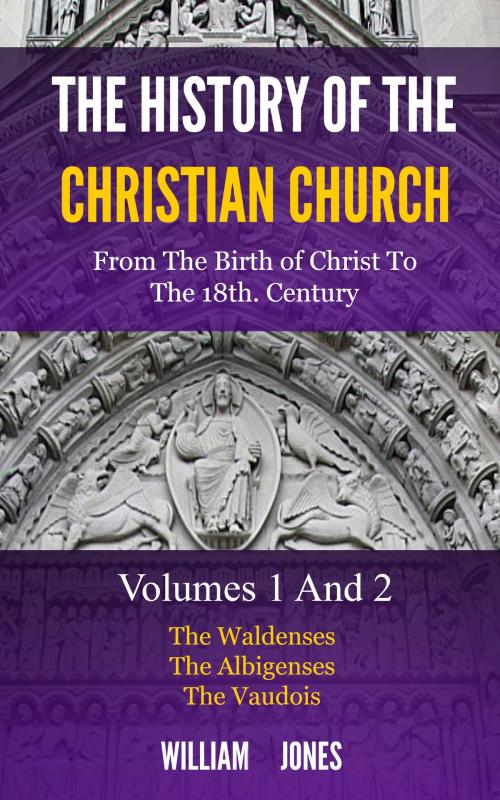The History of the Christian Church: From the Birth of Christ to the 18th Century
The Waldenses, The Albigenses, The Vaudois
Nonfiction, Religion & Spirituality, Christianity, Church, Church History, History, European General, General Christianity| Author: | Jones, William | ISBN: | 1230000499491 |
| Publisher: | Delmarva Publications, Inc. | Publication: | June 18, 2015 |
| Imprint: | Language: | English |
| Author: | Jones, William |
| ISBN: | 1230000499491 |
| Publisher: | Delmarva Publications, Inc. |
| Publication: | June 18, 2015 |
| Imprint: | |
| Language: | English |
The History of the Christian Church is a two volume set. Volume one traces the history of the Christian Church from the time of the apostles to the twelfth century. Jones includes helpful chronological tables of the kings, princes as well as the Popes, and emperors. Volume two starts at the time of the reformer Peter Waldo, A. D. 1160, and continues through the days of Wycliffe into the fourteenth century, and to the end of the seventeenth century. At the end there is an 80 page appendix of letters from Waldensian clergy members.
Even during the world’s midnight, when the dark cloud of papal superstition was spread in blackness over the moral sky of the civilized nations, here and there a star was seen, bright, beautiful and peculiar, pouring celestial splendor upon the surrounding gloom. When Popery was the world’s despot—when, with all deceivableness of unrighteousness, the Man of Sin had ascended to the throne of universal dominion—when Rome, under the Pontiff’s more than under the Caesars, was the mistress of the world—when the Pope had successfully maintained his right to dispose of sceptres and croziers, kingdoms and continents, according to his sovereign and arbitrary pleasure—when the kings and the chief captains of earth were his sycophants and serving men—even then there were multitudes of the meek and humble followers of our Savior who defied his power and refused to acknowledge his supremacy. And in this, history is the verification of prophecy. The same inspired seer that foretells the rise and reign of the Roman Anti-Christ, also predicts the persecutions and privations of those who, during the night of his dominion, should suffer for the witness of Jesus and the word of God. The church of God, though cast down, was never destroyed. The gates of hell never prevailed against it. God reserved myriads to himself who would not bow the knee to the Pope of Rome—who would not become his slaves and receive his mark upon their foreheads and in their hands. The papal church reeled intoxicated with their blood, but she never subdued them. They were horribly persecuted, and driven into the caves and dens of the earth, but they were never conquered. In the recesses of the wilderness and in the clefts of the mountains, they worshipped God in spirit and in truth, uncontaminated by surrounding corruptions and unterrified by the frowns of power.
Eminent among these witnesses for the truth in times of general apostacy, stand the Waldenses. They first appear prominent in history in the twelfth century. Long before that, no doubt, in the valleys of the Alps, they had maintained the true religion, having retreated from the corruptions and persecutions of the Roman church.
The History of the Christian Church is a two volume set. Volume one traces the history of the Christian Church from the time of the apostles to the twelfth century. Jones includes helpful chronological tables of the kings, princes as well as the Popes, and emperors. Volume two starts at the time of the reformer Peter Waldo, A. D. 1160, and continues through the days of Wycliffe into the fourteenth century, and to the end of the seventeenth century. At the end there is an 80 page appendix of letters from Waldensian clergy members.
Even during the world’s midnight, when the dark cloud of papal superstition was spread in blackness over the moral sky of the civilized nations, here and there a star was seen, bright, beautiful and peculiar, pouring celestial splendor upon the surrounding gloom. When Popery was the world’s despot—when, with all deceivableness of unrighteousness, the Man of Sin had ascended to the throne of universal dominion—when Rome, under the Pontiff’s more than under the Caesars, was the mistress of the world—when the Pope had successfully maintained his right to dispose of sceptres and croziers, kingdoms and continents, according to his sovereign and arbitrary pleasure—when the kings and the chief captains of earth were his sycophants and serving men—even then there were multitudes of the meek and humble followers of our Savior who defied his power and refused to acknowledge his supremacy. And in this, history is the verification of prophecy. The same inspired seer that foretells the rise and reign of the Roman Anti-Christ, also predicts the persecutions and privations of those who, during the night of his dominion, should suffer for the witness of Jesus and the word of God. The church of God, though cast down, was never destroyed. The gates of hell never prevailed against it. God reserved myriads to himself who would not bow the knee to the Pope of Rome—who would not become his slaves and receive his mark upon their foreheads and in their hands. The papal church reeled intoxicated with their blood, but she never subdued them. They were horribly persecuted, and driven into the caves and dens of the earth, but they were never conquered. In the recesses of the wilderness and in the clefts of the mountains, they worshipped God in spirit and in truth, uncontaminated by surrounding corruptions and unterrified by the frowns of power.
Eminent among these witnesses for the truth in times of general apostacy, stand the Waldenses. They first appear prominent in history in the twelfth century. Long before that, no doubt, in the valleys of the Alps, they had maintained the true religion, having retreated from the corruptions and persecutions of the Roman church.















